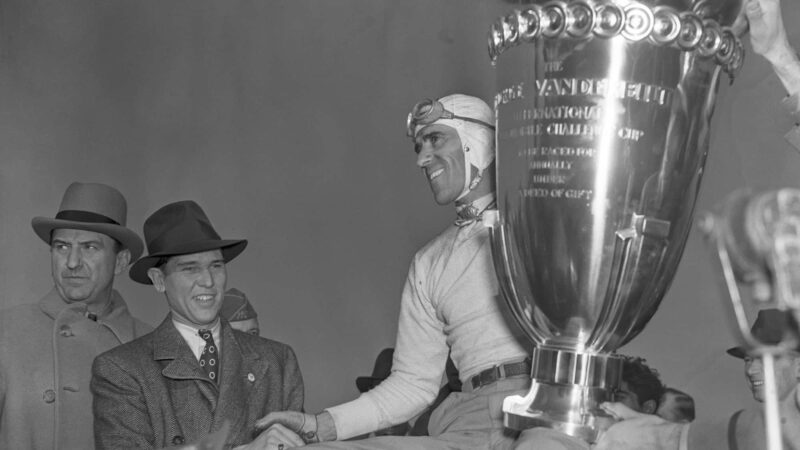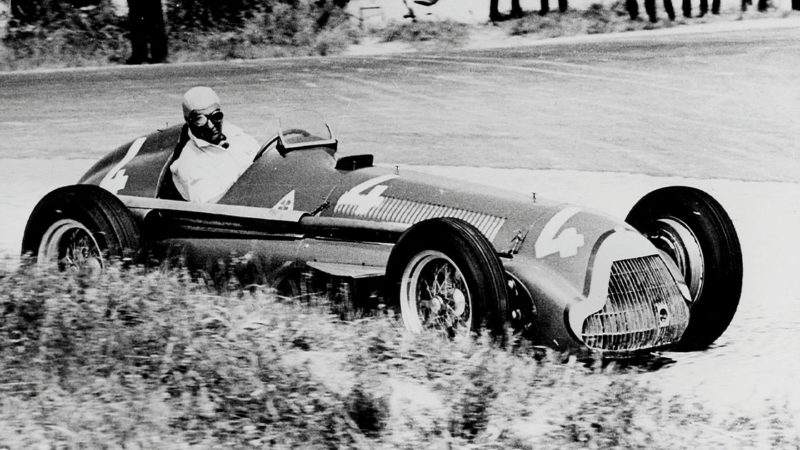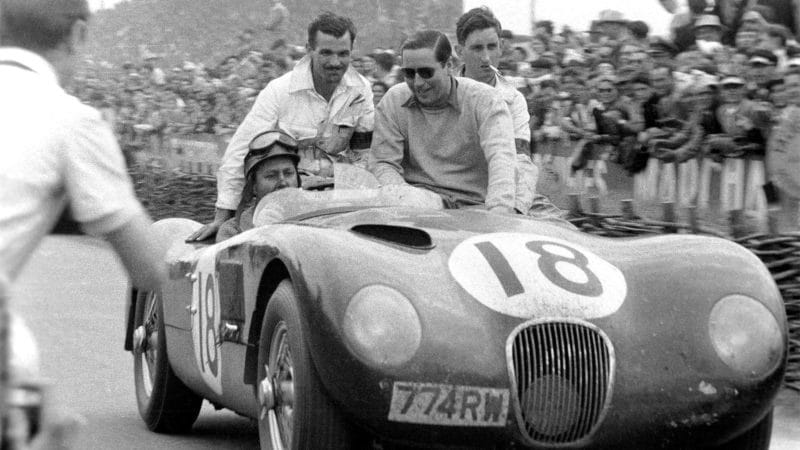I carried on, passing abandoned vehicles at regular intervals. At Woodcote I only just made it owing to the wind, which on the apex blew me gently across the track to the verge.
When the cloudburst began to abate I could make full use of that remarkable vehicle, the B-type ERA. You could not want a better car for such conditions. Firstly, one sat high and clear of the spray; secondly, the centre of gravity being high there was considerable weight transference to the outside, causing the tyres to bite through the slippery conditions. Lastly, the wonderful torque, which allowed me to leave it in top gear, like a big-engined car, and concentrate on looking for changes of surface from shiny smooth to matt rough where there was more grip and more throttle could be used, whether they were on the right line or not.
So it went on for a dozen laps with no one in sight until suddenly there was the chequered flag. At my pit there was unusual excitement. It appeared I was second, and had been closing on Fangio since the storm at a rate of one or two seconds a lap. According to my mechanic Harold, the Alfa pit had given Fangio a ‘faster’ signal. I cannot vouch for the truth of this, but it is a flattering thought.
For years I thought that if only I had been a few seconds nearer and in sight of Fangio I might even have caught him, but now I know that I could never have done so, for he drove with his head as much as with his hands. His nearest rival was out of sight and therefore he drove as slowly as possible in the appalling conditions.
The final was, for me, rather an anti-climax; I did manage to beat Bob, but not by straight driving – he overdid it and spun.
On Tazio Nuvolari

Cup runneth over: Nuvolari takes the prize from the Vanderbilt Cup’s namesake George
Bettmann / Getty Images
The question will always be asked ‘who was the world’s greatest driver?’. Until recently I would have said ‘Nuvolari’ without hesitation. Now I would say ‘Nuvolari or Fangio’. It is impossible to compare great drivers who have lived at different times. I count myself lucky to have seen two great artists at work – Nuvolari at the wheel and Toscanini conducting. Both were Italian, both supreme artists in their sphere. I first saw Nuvolari drive a 2.3 Alfa Romeo at Le Mans in 1933 in the race he won by seconds partnered by Raymond Sommer (below). I watched from the Esses; one saw the Alfa come over the rise, a small figure sitting high in the car, two wiry brown arms, an immense jutting chin and then a quick side view as the little man flicked the car first left, then right. Such was the concentration, the determination of his whole figure that one imagined some invisible force entering the car. Like Fangio he drove with his head as well as his hands, for the victory hinged on who ‘slip-streamed’ last and so led on the last lap, so closely was it fought with Luigi Chinetti in a similar car.
Slip-streaming is a curious business. On the long straight at Le Mans, a car closely following another finds he is drawing up to the car in front. When he pulls out to overtake one would expect that, being subjected to the full force of the wind, his speed would drop to that of his rival. In fact the momentum gained by slip-streaming is enough to carry the second car past the first. I know, for I have done this very thing in an Aston Martin DB2 at Le Mans to Eric Thompson.
There are two places at Le Mans where one can do this, down the Mulsanne straight and between Whitehouse corner and the pits. Nuvolari and Chinetti were together on their last lap. Nuvolari kept station behind Chinetti down Mulsanne and left his effort to the Whitehouse corner. This needed courage, for there is only just time to rely on slipstream overtaking. However, he did, and gained the flag.
Although I think Fangio has equalled Nuvolari in the number and quality of his feats, to me the words Nuvolari and Alfa Romeo will always cause my heart to beat faster. At the time of his victories I was young, and the magic of youth can never be recaptured.
On Reg Parnell

From Derby to Silverstone via Milan: Reg Parnell was the only homegrown hope for victory at the 1950 British GP
Getty Images
I come now to a strange and unhappy episode, which I relate under Reg’s name only because he was one of the characters involved.
During the 1951 season I was invited by Tony Vandervell to drive his Thinwall Special, basically a 4½-litre Ferrari, at Reims. Reg had driven the car up till then with considerable skill and success but could not do so at Reims having accepted an invitation to drive the ill-fated BRM. Accordingly, Mr Vandervell selected me faute de mieux.
From the moment I got to Reims things seemed odd. When I asked at the team’s hotel for my room I found that I had been booked in at a different hotel. Eventually I met up with the team. No one seemed quite so affable as they had been in England; in fact there was a distinct atmosphere.
Reg was with the others and it came out that the BRM entry had been cancelled, and that Reg was therefore free. I fully expected someone to ask me to stand down in his favour, as he had twice my experience and knew both car and course. However, nothing was said; the atmosphere merely thickened. Looking back, I should of course have had it out with Mr Vandervell, but kept thinking that the move was bound to come from his side.
Eventually the first practice session arrived. I was in a frightful state of nerves. What with the atmosphere and the fact that I was driving a much faster car than I had been used to, I was suffering what the RAF termed ‘lack of moral fibre’. I had worked myself up into an additional state over the car, on which the front transverse spring had been modified.



